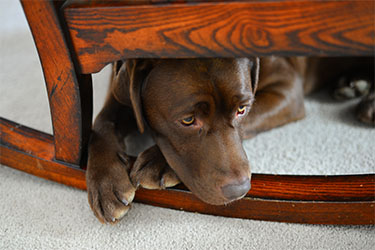Veterinarians: Separation Anxiety Tips for Clients

A dog that misbehaves when left alone is often described as having separation-behavioral issues. However, there is a difference between a dog that is being naughty and one that is experiencing true separation anxiety.
Bad Behavior
Some dogs seem to excel at bad behavior when they are left unsupervised. It isn’t uncommon for a family to return home to find a happy pup in the middle of a mess. Dogs that are bored or lonely often:
- Go to the bathroom in the house
- Get into the trash
- Tear up blankets, pillows, or clothing
- Chew on things not meant to be chewed!
While the bad behavior occurred when the animal was left home alone, it doesn’t necessarily mean that it was caused by anxiety at being left alone. Clients need to know that if their dog falls into this category, it may benefit from obedience training that focuses on manners for behaving when in the house.
Separation Anxiety
When a dog experiences separation anxiety, the same types of misbehaviors are present, but the level of damage tends to be significantly greater. In addition, the problem behaviors are now accompanied by behaviors of distress which may include:
- Drooling
- Whining
- Appearing depressed or agitated
- Sitting in front of the door.
Causes
The reason why some dogs develop separation anxiety is not understood. Given that it only occurs when the dog is separated from its person, the underlying cause may be attributed to a loss the animal suffered during its life. Possible explanations include:
- Changes involving the people living in the animal’s home
- The dog’s favorite person is suddenly absent due to moving away or death.
- Change of family
- The dog loses its family and home by being abandoned, taken to a shelter, or given to a new family
- Change in routine
- If the dog is used to its person working from home, but they take a new job that requires them to leave and go to work, the animal may begin to feel anxious at being left at home alone for longer hours.
Behaviors
Upset at being separated from their family, the animal may begin to show distressed behavior as they witness their person preparing to leave. Once they leave, the animal reacts further and may be observed to:
- Bark, howl, or whine incessantly
- Pace for hours
- Scratch and chew to get through a door, wall, or crate
- Rip down curtains
- Destroy furniture
- Chew and pull out water pipes under sinks and behind toilets.
The dog’s anxiety level increases as it continues to try to get to its people. When this happens, the animal is at risk of causing itself harm. Dogs with separation anxiety m
ump or hurl themselves upon doors or windows, breaking the glass and getting cut - Climb atop furniture, causing it to fall over, pinning the animal underneath
- Claw, dig, and chew at its crate to get out, resulting in pulling the sides in and the doors off, breaking teeth, damaging toes and injuring themselves by getting stuck
- Chew through wood doors or frames, causing damage to their mouth
- Scratch and dig through walls or fencing, injuring feet and pulling out toenails
- Defecate and consume some or all of their excrement.
How Clients Can Help Their Pet Overcome Separation Anxiety
Advise your client that establishing a routine is important when trying to help a dog cope with separation anxiety. Tell them to, for example:
- Try to keep the pre-leaving time low-key and relaxed:
- Take the animal for a long walk, don’t just let it out to go to the bathroom
- Spend time playing with the dog to release any pent-up energy.
- Focus on changing the animal’s negative reaction to one that is positive by helping the animal learn to associate being left alone with something good coming to them:
- Just before leaving, direct the dog’s attention away from being left alone by offering it something it likes, for example:
- A favorite play toy
- A puzzle toy stuffed with peanut butter, cream cheese, kibble, or canned food
- Just before leaving, direct the dog’s attention away from being left alone by offering it something it likes, for example:
- In order for this to work, the association must be made every time the separation occurs and only be given to the dog for the time that they are left alone.
Additional Client Tips:
- Before leaving the house:
- Make sure the temperature is comfortable
- Turn on the television or radio so the animal doesn’t feel alone
- Provide it with a favorite toy or blanket
- Do not fuss over the animal as you leave. Keep your exit simple
- If the animal begins to cry, do not go back inside
When a pet experiences severe symptoms of separation anxiety, the approach offered above may not work. Clients of highly anxious animals may benefit from talking to a professional that is qualified to provide experience in treating fear. In such situations, you may want to refer them to a board-certified veterinary behaviorist or a Certified Applied Animal Behaviorist.
Contact your Covetrus representative for additional information at 855.724.3461.
Careers
Are you looking for a place to let your talents shine? At Covetrus, we help our practitioner customers better serve their patients and take pride in providing the best customer experience possible. Search our open positions to see our available opportunities.
Newsletter
Stay current with what’s going on with Covetrus, subscribe to receive our newsletter and email communications. Subscribers will receive the latest information in practice management, sales and marketing, animal health, and more.


Leave a comment